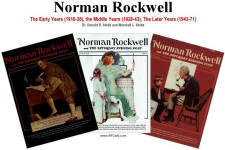 My mother loved Norman Rockwell
paintings for their ability to get to the heart of Americana. She was an avid
collector of books on Rockwell and decorated plates for display - as avid as one
can be on my newspaper classified ad manager
father's feeble salary, anyway.
I, too, have a great appreciation for Rockwell's great talent to choose his
subject matter and models and to, when fitting, include a nearly photographic
level of detail within. The Saturday Evening Post magazine featured many of his
works spanning from 1916 until 1971 - from the middle of World War I and on
through World War II, Korea, and Vietnam. Summer, spring, fall, and winter;
Christmas, Easter, Veteran's Day, President's Day, Mother's Day, New Year's, and
other annual events; experiences of love, happiness, joy, surprise, sadness, and
a host of other emotions were expressed in the bodies and visages of American
families and persons, from the very young to the very old; technology in its
natural evolution necessarily found it way into the pictures' backgrounds, often
in a subtle manner becoming the primary theme. Rockwell captured the totality of
current events during his lifetime in a famously non-offensive, personal manner.
His collective works represent an America that, in the eyes of her enemies, was
in need of fundamental change.
Both of my parents have been gone for many decades and I possessed almost nothing
of their personal items until recently when my sister sent me the three books that
were my mother's shown to the left that contain all the cover art produced by Norman
Rockwell for The Saturday Evening Post. While looking through them I ran
across some familiar paintings that contain radio and television related themes
- surprisingly few given the many hundreds of paintings done by Rockwell. The first
appeared in 1922 as a crystal radio set, and the next didn't appear until 22 years
later in a WWII theme. Prior to that time, Rockwell produced an enlistment poster
for the U.S. Army showing a telegraphy specialist, and in 1920 painted a cover piece
for The Literary Digest depicting a young Ham radio operator demonstrating his rig
to his grandfather. Rockwell always used real people and scenes for his subjects,
so chances are the equipment shown accurately reflects actual equipment, although
company brand names are rarely revealed. Maybe you recognize the radio models in
the painting? I do not.
Over the past couple years I have scanned and posted a few articles and advertisements
from technology companies from editions of The Saturday Evening Post that
I bought on eBay, such as this two-page ad for
General Electric radios and televisions for the Christmas 1948
shopping season (links to others are at the bottom of the page).
|

"Wonders of Radio" - Norman Rockwell
May 20, 1922 The Saturday Evening Post
"The couple's listening preferences are seen in the newspaper program indicating
the time of opera the broadcast. The tortoise-shell comb in the woman's hair suggests
in her lifetime she has been more than a listener. One can imagine her as a fiery
Carmen or a teasing Manon Lescaut. By 1922 most people had parlor sets so this crystal
radio with earphones is a look back. A model remembers Rockwell himself listening
to the World Series from a crystal set while he painted." - Dr. Donald
R. Stoltz and Marshall L. Stoltz
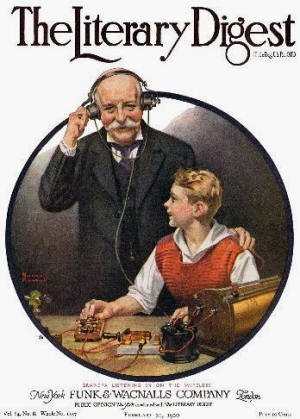
"Grandpa Listening in on the Wireless" - Norman Rockwell
February 21, 1920 The Literary Digest

"U.S. Army Teaches a Trade" - Norman Rockwell
1919 United States Army recruiting poster
"Norman Rockwell's image of a G.I. telegrapher was meant to promote one of the
benefits of military service: Army training would prepare a soldier with skills
needed to get a job upon return to civilian life. This painting was one of several
which Rockwell completed in the style of his friend and fellow Saturday Evening
Post illustrator, J.C. Leyendecker. Well-known for advertising images commissioned
by Arrow Shirt Collars, and House of Kuppenheimer, Leyendecker's deliberately thick,
visible brushstrokes were emulated by Rockwell in this work. The inclusion of a
border with related thematic insignias was also a motif which Leyendecker regularly
employed."

"Imperfect Fit (Back to Civvies)" - Norman Rockwell
December 15, 1945 The Saturday Evening Post
"When Norman Rockwell began this cover, he found out that Lieutenant Arthur F.
Becktoft, Jr., had just come home. Becktoft, a Flying Fortress pilot, who made an
excellent record in Europe and was shot down in a mission over Germany, had lived
to tell the story. Norman caught hime in this unforgettable scene when, after being
away for four years and wearing the uniform of the United States Air Force, he found
that he had matured not only morally and mentally, but certainly in stature as well."
- Dr. Donald R. Stoltz and Marshall L. Stoltz
|
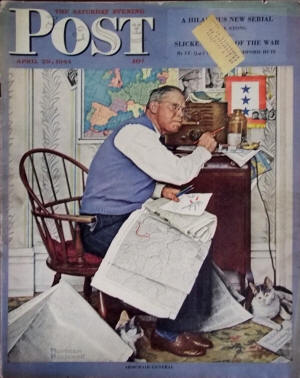
"Armchair General" - Norman Rockwell
April 29, 1944 The Saturday Evening Post
"Despite the times, this cover shows a definite note of optimism. As the war
rages on, this father of three servicemen stays closely tuned in to his radio. Monitoring
the war's developments, he carefully pencils in each advance and each retreat with
the deftness of a battlefield general. The square jaw and tightly clenched cigar
show the air of determination not only of this armchair general but of Americans
the world over."
- Dr. Donald R. Stoltz and Marshall L. Stoltz
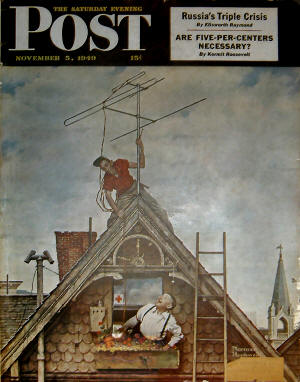
"New Television Set" - Norman Rockwell
November 5, 1949 The Saturday Evening Post
"This particular house was in the Adams Street neighborhood of Los Angeles. It
is hard to believe that this old-timer was once one of the newest and snazziest
homes. It's hard to believe, too, that the occupants of the home would think that
someday there would be a contraption on their rooftop enabling people inside to
see what was going on fifty miles away. They, no matter how primitive the television,
no matter how cloudy the ghost of the picture it will still bring a great deal of
joy to those people sitting down and watching for the first time their own T.V.
set."
- Dr. Donald R. Stoltz and Marshall L. Stoltz
These Rockwell paintings do not feature radios, but they
are amongst my favorites: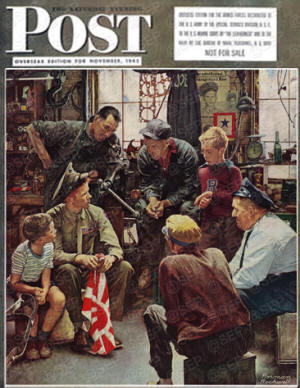
"Homecoming
Marine" - Norman Rockwell
October 13, 1945 The Saturday Evening Post
If you love cars and engines and tools and gaskets and thread dies, then this
painting will strike your fancy for sure. The attention to detail is amazing.
Norman Rockwell Museum Collection
|
Posted February 14, 2019
(original 2/16/2014)
|
















